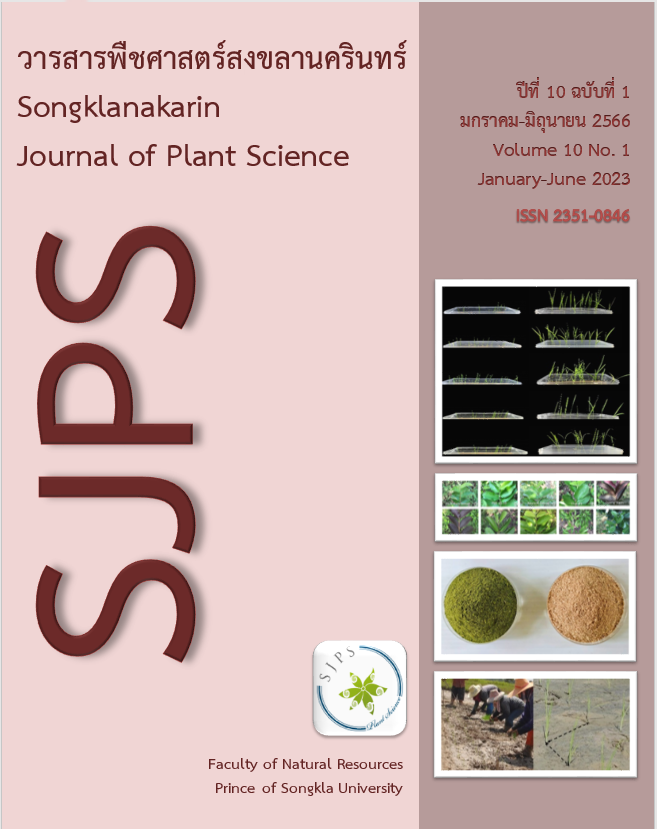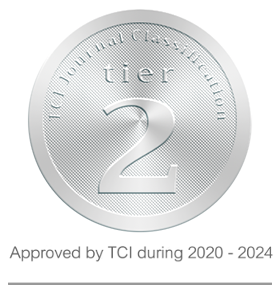Stimulation Seedling Growth in Rice by Seed Priming and Foliar Application with Fish Amino Acid
Keywords:
Seed enhancement , Seed germination , Chlorophyll content , Foliar fertilizerAbstract
Foliar application with fish amino acids is a method that can maximize uptake and minimize runoff or leaching, providing just enough N to the plant for optimum uptake and the production of chlorophyll to increase plant growth and maintain plant health. The purpose of this research was to study the effect of seed priming method and foliar spraying rate of marine fish amino acids on the growth of Sang Yod rice seedlings. Split plot experiments were planned. The main factor was foliar spraying with Fish Amino Acid (FAA) at four concentrations: 0%, 0.10%, 0.15%, and 0.20%. Secondary factors were seed soaked in 5 treatments, i.e., no priming (control), hydropriming, 0.10% FAA, 0.15% FAA, and 0.20% FAA. Seedling growth, leaf area, and chlorophyll content were recorded. It was found that soaking seeds with FAA before germination in sand at different rates resulted in statistically significant differences in the percentage germination of rice seedlings. Soaking seeds in water and 0.10% FAA resulted in maximum germination of 99% and 98%, respectively, and mean germination time at 3 days. Seed soaking at 0.10% concentration combined with FAA foliar spray at rate 0.15% promotes the growth of seedlings both shoots and roots, increased leaf area and chlorophyll content. As a result, the photosynthetic efficiency of the rice plant was increased.
References
Aung, L.H. and Flick, G.J. 1980. The influence of fish solubles on growth and fruiting of tomato. Horticultural Science 15: 32-33.
Colla, G., Nardi, S., Cardarelli, M., Ertani, A., Lucini, L., Canaguier, R. and Rouphael, Y. 2015. Protein hydrolysates as biostimulants in horticulture. Scientia Horticulturae 196: 28–29.
Dharmanitivedya, S. 2019. Pigment Extraction from plant leaves for plant physiology studies. Naresoan Agricultural Journal 16: 73-81.
Ellis, R.H. and Roberts, E.H. 1980. Improved equations for the prediction of seed longevity. Annals of Botany 45: 13–30.
Ertani, A., Pizzeghelio, D., Altissimo, A. and Nardi, S. 2013. Use of meat hydrolyzate derived from tanning residues as plant biostimulant for hydroponically grown maize. Journal of Plant Nutrition and Soil Science 176: 287-296.
Ertani, A., Cavani, L., Pizzeghello, D., Brandellero, E., Altissimo, A., Ciavatta, C. and Nardi., S. 2009. Biostimulant activity of two protein hydrolyzates in the growth and nitrogen metabolism of maize seedlings. Journal of Plant Nutrition and Soil Science 172: 237-244.
Gioseffi, E., de Neergaard, A. and Schjoerring, J.K. 2012. Interactions between uptake of amino acids and inorganic nitrogen in wheat plants. Biogeosciences 9: 1509-1518.
ISTA. 2011. International Rules of Seed Testing. Bassersdorf: International Seed Testing Association, Switzerland.
Jumar, R., Saputra, A., and Jannah, S.R. 2021. Effect of fish amino acid application on growth and N-uptake in plants rice using the system of rice intensification method. Tropical Wetland Journal 7: 25-30.
Naroozlo, Y.A., Souri, K.M. and Mojtaba, D. 2019. Stimulation effects of foliar applied glycine and glutamine amino acids on lettuce growth. Open Agriculture 4: 164.
Nacry, P., Bouguyon, E. and Gojon, A. 2013. Nitrogen acquisition by roots: physiological and developmental mechanisms ensuring plant adaptation to a fluctuating resource. Plant and Soil 370: 1-29.
Paleckiene, R., Sviklas, A. and Šlinkšiene, R. 2007. Physicochemical properties of a microelement fertilizer with amino acids. Russian Journal of Applied Chemistry 80: 352–357.
Parrado, J., Bautista, J., Romero, E.F., Garcı´a-Martı´nez, A.M., Friaza, V. and Tejada, M. 2008. Production of a carob enzymatic extract: Potential use as a biofertilizer. Bioresource Technology 99: 2312-2318.
Priyanka, B., Ramesh, T., Rathika, S. and Balasubramaniam, P. 2019. Foliar application of fish amino acid and egg amino acid to Improve the physiological parameters of rice. International Journal of Current Microbiology and Applied Sciences 8: 3005-3009.
Schiavon, M., Ertani, A. and Nardi, S. 2008. Effects of an alfalfa protein hydrolysate on the gene expression and activity of enzymes of the tricarboxylic acid (TCA) cycle and nitrogen metabolism in Zea mays L. Journal of Agricultural and Food Chemistry 56: 11800-11808.
Shahidi, F., Han, X.Q. and Synowiecki, J. 1995. Production and characteristics of protein hydrolysates from capelin (Mallotus villosus). Food Chemistry 53: 285-293.
Siri, B. 2015. Seed Conditioning and Seed Enhancements. Khon Kaen: Department of Plant Science and Agricultural Resource, Khon Kaen University.
Stiegler, J.C., Richardson, M.D., Karcher, D.E., Roberts, T.L. and Norman, R.J. 2013. Foliar absorption of various inorganic and organic nitrogen sources by creeping bentgrass. Crop Science 52: 1148-1152.
Subbarao, S.B., Hussain, I.S.A. and Ganesh, P.T. 2015. Bio stimulant activity of protein hydrolysate: influence on plant growth and yield. Journal of Plant Science and Research 2: 125.
Trevisan, S., Manoli, A., Ravazzolo, L., Franceschi, C. and Quaggiotti, S. 2017. mRNA-Sequencing analysis reveals transcriptional changes in root of maize seedlings treated with two increasing concentrations of a new biostimulant. Journal of Agricultural and Food Chemistry 65: 9956–9969.
Trevisan, S., Manoli, A. and Quaggiotti, S. 2019. A novel biostimulant, belonging to protein hydrolysates, mitigates abiotic stress effects on maize seedlings grown in hydroponics. Agronomy 9: 28.
Weinert, E.J., Miller, S.A., Ikeda, D.M., Chang, K.S., McGinn, J.M. and DuPonte, M.W. 2014. Natural Farming: Fish Amino Acid. Sustainable Agriculture, SA-12. Hawai’i: University of Hawai’i, College of Tropical Agriculture and Human Resources.
Welburn, A.R. 1994. The spectral determination of chlorophylls a and b, as well as carotenoids, using various solvents with spectrophotometers of different resolution. Journal of Plant Physiology 144: 307-313.
Wilson, H.T., Xu, K. and Taylor, A.G. 2015. Transcriptome analysis of gelatin seed treatment as a biostimulant of cucumber plant growth. The Scientific World Journal 2015: 391234. https://doi.org/10.1155/2015/391234
Yoshida, S., Forno, D.A., Cock, J.H. and Gomez, K.A. 1976. Laboratory manual for physiological studies of rice, 3rd ed. Manila: International Rice Research Institutes, Philippines.
Yuan, L., Wu, L., Yang, C. and Lv, Q. 2013. Effects of iron and zinc foliar applications on rice plants and their grain accumulation and grain nutritional quality. Journal of the Science of Food and Agriculture 93: 254-261.
Downloads
Published
How to Cite
Issue
Section
License
Copyright (c) 2023 Songklanakarin Journal of Plant Science

This work is licensed under a Creative Commons Attribution-NonCommercial-NoDerivatives 4.0 International License.



